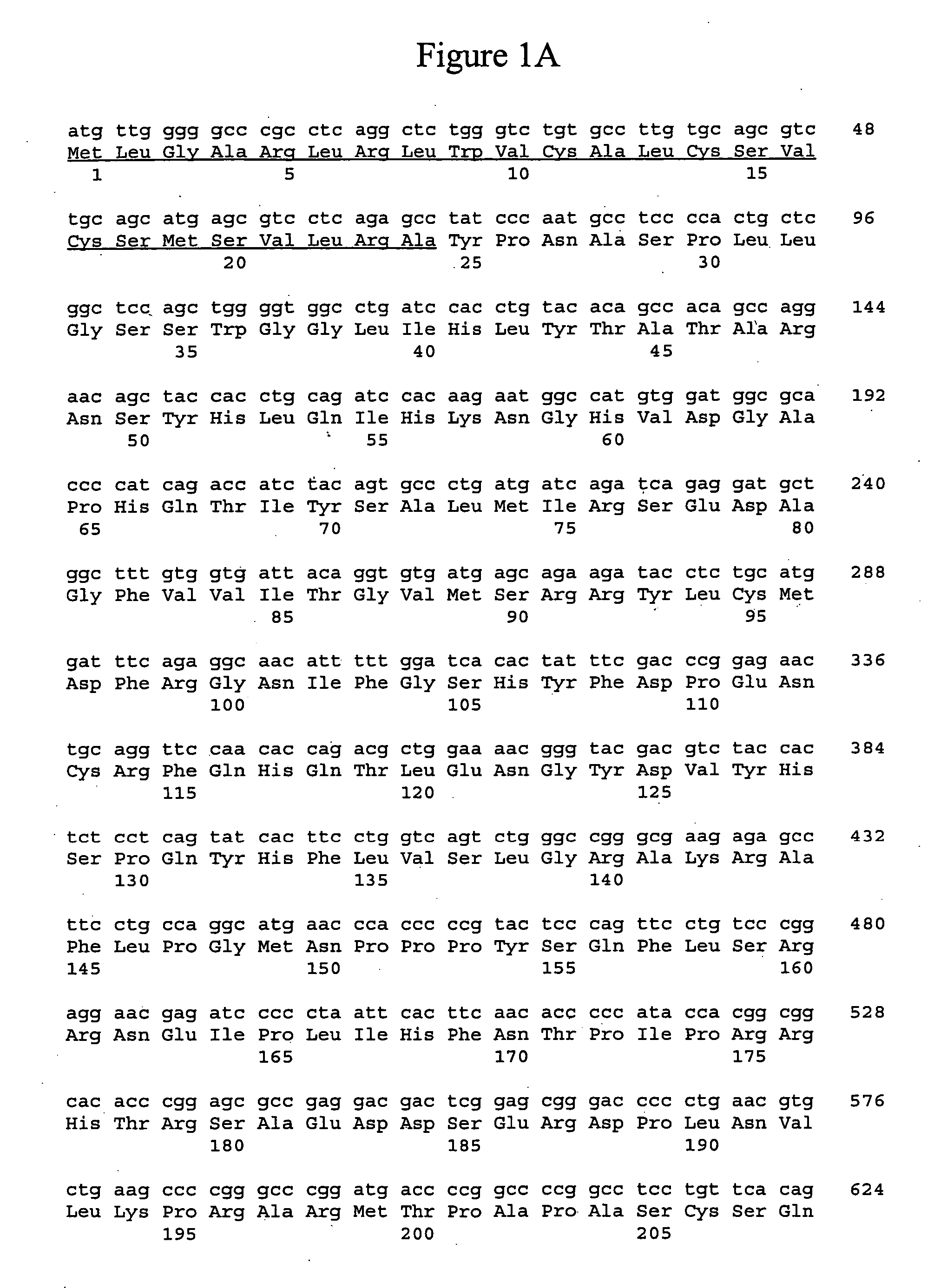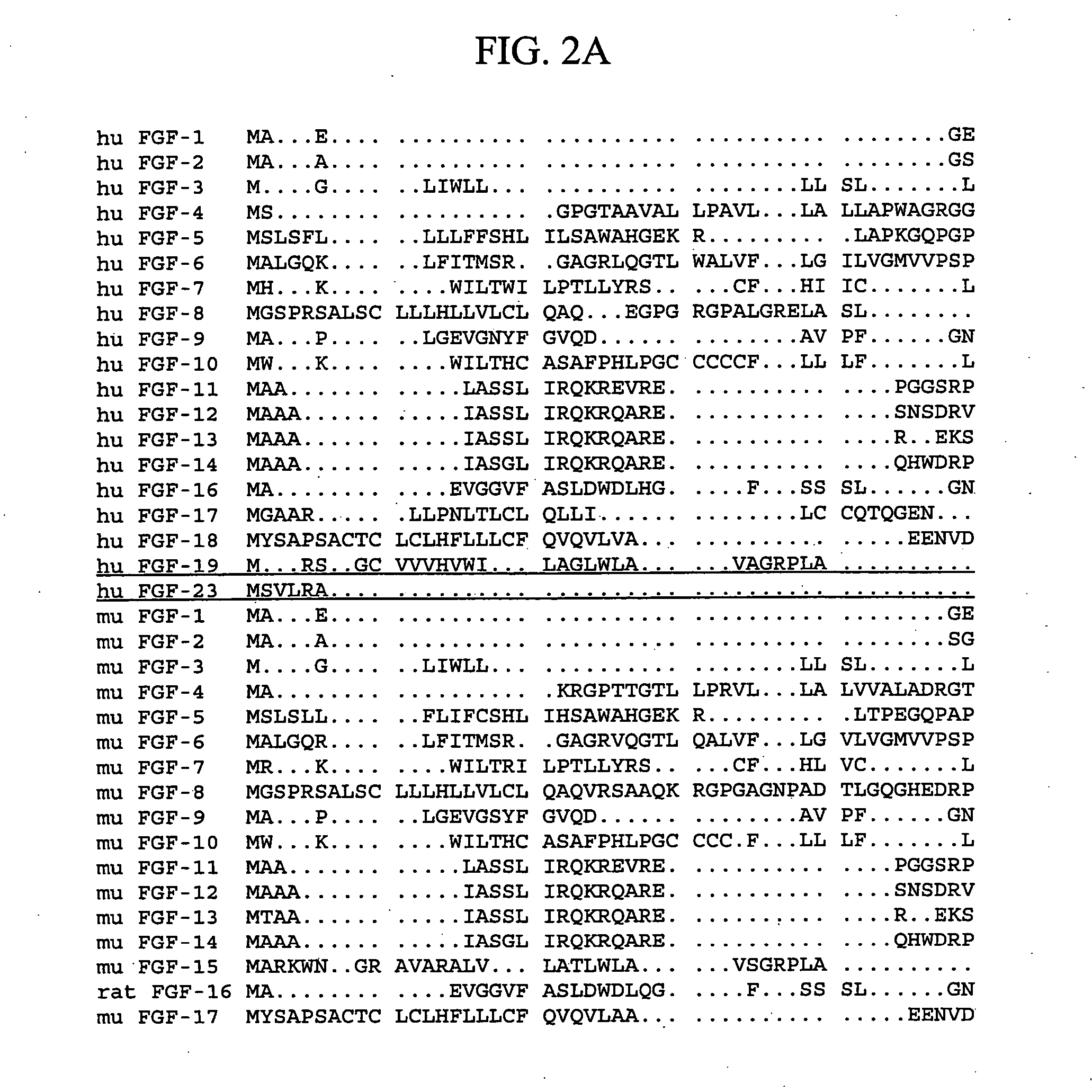Fibroblast Growth Factor-23 molecules and uses thereof
a technology of growth factor and fibroblast, which is applied in the direction of peptide/protein ingredients, immunoglobulins, peptides, etc., can solve the problem that the potential for the development of novel therapeutics based on the human genome is still largely unrealized
- Summary
- Abstract
- Description
- Claims
- Application Information
AI Technical Summary
Benefits of technology
Problems solved by technology
Method used
Image
Examples
example 1
Cloning of the Human FGF-23 Polypeptide Gene
[0315] To isolate cDNA sequences encoding human FGF-23 polypeptide, homology-based BLAST searches of a human genomic database were performed. A putative coding sequence sharing homology with the Fibroblast Growth Factor (FGF) family was identified in a human genomic clone (GenBank accession no. AC008012). The putative coding sequence consisted of three potential exons separated by introns of 6.6 kb and 1.87 kb. This sequence was used to design gene specific oligonucleotides for the identification of cDNA sources and the generation of cDNA clones, using various PCR strategies.
[0316] A number of cDNA libraries were analyzed in amplification reactions containing 10 pmol each of the amplimers (5′-C-T-A-T-C-C-C-A-A-T-G-C-C-T-C-C-C-C-A-C-T-G-3′; SEQ ID NO: 42, and 5′-C-G-C-C-C-C-T-G-A-C-C-A-C-C-C-C-T-A-A-T-G-3′; SEQ ID NO: 43) and Ready-To-Go PCR beads (Pharmacia, Piscataway, N.J.), in a total reaction volume of 250 μl. Reactions were performe...
example 2
FGF-23 mRNA Expression
[0325] The expression of FGF-23 was analyzed by RT-PCR. Total RNA was prepared from various human fetal tissues using standard techniques. Template and primer mixtures were prepared using 2 μg of total RNA and 50 ng of random primer (Gibco-BRL) in a volume of 12 μl. The mixtures were heated to 70° C. for 10 minutes and then chilled on ice. Reverse transcription was performed by adding 4 μl of 5× first strand buffer (Gibco-BRL), 2 μl of 0.1 M DTT, and 1 μl of 10 mM dNTPs to the template-primer mixture, warming the reaction mixture to 37° C. for 2 minutes, adding 1 μl of Superscript II RT (Gibco-BRL), and then incubating the reaction mixture at 37° C. for 1 hour.
[0326] Differences in RNA concentration and cDNA conversion efficiency were normalized by performing control PCR amplifications on each cDNA sample using primers specific for glyceraldehyde-3-phosphate dehydrogenase (G3PDH), a gene expected to be expressed at about the same level in all of the tissues t...
example 3
Production of FGF-23 Polypeptides
A. Expression of FGF-23 Polypeptides in Bacteria
[0335] PCR is used to amplify template DNA sequences encoding an FGF-23 polypeptide using primers corresponding to the 5′ and 3′ ends of the sequence. The amplified DNA products may be modified to contain restriction enzyme sites to allow for insertion into expression vectors. PCR products are gel purified and inserted into expression vectors using standard recombinant DNA methodology. An exemplary vector, such as pAMG21 (ATCC no. 98113) containing the lux promoter and a gene encoding kanamycin resistance is digested with Bam HI and Nde I for directional cloning of inserted DNA. The ligated mixture is transformed into an E. coli host strain by electroporation and transformants are selected for kanamycin resistance. Plasmid DNA from selected colonies is isolated and subjected to DNA sequencing to confirm the presence of the insert.
[0336] Transformed host cells are incubated in 2×YT medium containing ...
PUM
| Property | Measurement | Unit |
|---|---|---|
| melting temperature | aaaaa | aaaaa |
| melting temperature | aaaaa | aaaaa |
| melting temperature | aaaaa | aaaaa |
Abstract
Description
Claims
Application Information
 Login to View More
Login to View More - R&D
- Intellectual Property
- Life Sciences
- Materials
- Tech Scout
- Unparalleled Data Quality
- Higher Quality Content
- 60% Fewer Hallucinations
Browse by: Latest US Patents, China's latest patents, Technical Efficacy Thesaurus, Application Domain, Technology Topic, Popular Technical Reports.
© 2025 PatSnap. All rights reserved.Legal|Privacy policy|Modern Slavery Act Transparency Statement|Sitemap|About US| Contact US: help@patsnap.com



